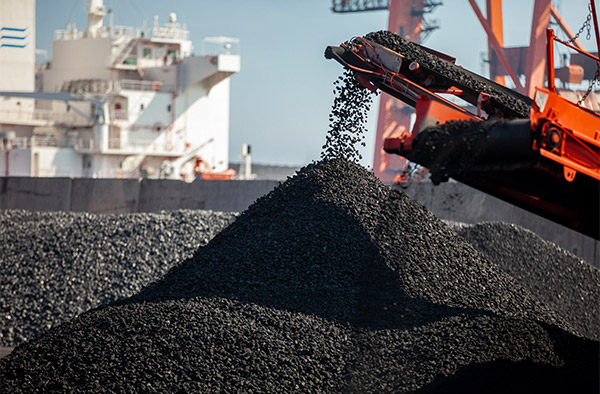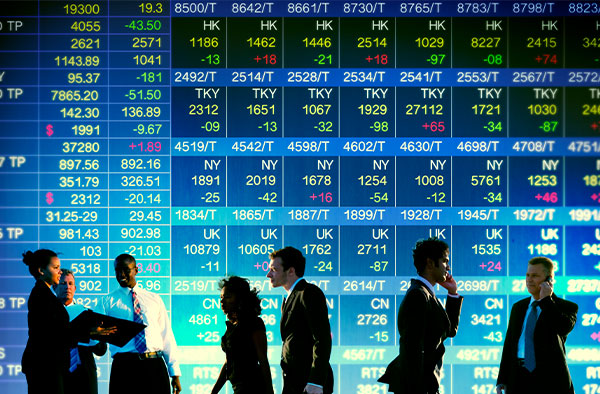
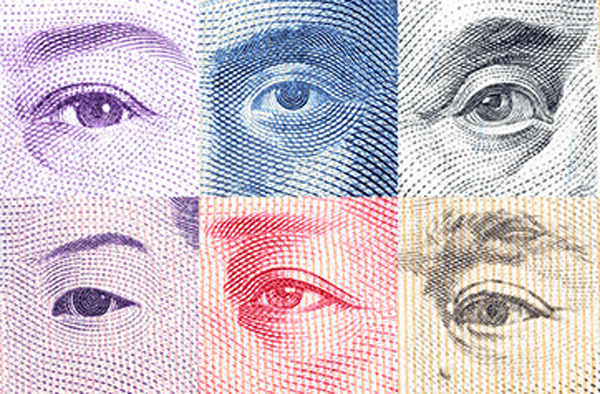
Top 10 Central Banks Have Raised Rates a Combined 2,000 Basis Points So Far this Cycle
This week marked the official start of autumn—or so we’re told. Here in San Antonio, the daytime high temperatures are still hovering in the mid-90s.
The week also felt like a huge pivotal shift in global central banks’ fight against sticky price inflation. Monetary policymakers added 350 basis points (bps) in rate hikes, bringing the total amount of hikes in the world’s top 10 largest economies to a massive ~2,000 bps so far this cycle, according to Reuters. The single holdout is Japan, which is still facing only moderate inflation of under 3%.
Central banks aren’t close to being done, of course. The Federal Reserve projects that the U.S. rate will be 4.4% by year-end, before peaking at 4.6% in 2023. Some macro research firms believe we’ll see 5%.
The question is: Will this even have an effect on inflation? The Fed has historically had to raise rates well above the annual consumer price index (CPI) to make a difference, but that’s been a tall order for Jerome Powell, whose starting point was essentially 0%.
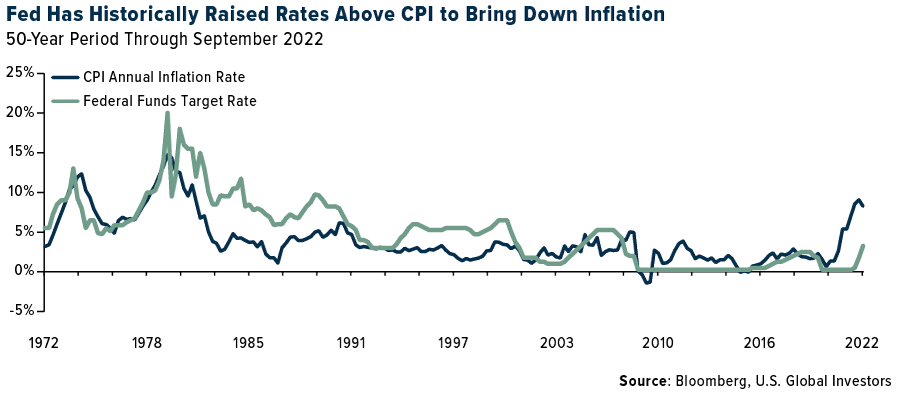
Will Higher Rates Trigger a Recession?
The risk is that the Fed’s medicine could be ineffective yet come with serious side-effects. It’s possible that current rate hikes won’t be enough to bring down inflation, but they may be enough to trigger a recession. Then we’re dealing with stagflation, the toxic combination between rising prices and rising unemployment. The next CPI report is scheduled to be released on October 13, and I’m hopeful we’ll see that inflation continue to slow.
Below is the so-called Misery Index, which adds together the monthly unemployment rate and monthly inflation rate. We haven’t reached 1970s levels yet, but the trend is clearly going in the wrong direction.
If we’re not in a recession already, this may be as close to being the highest level outside of an economic pullback as we’ve ever seen.
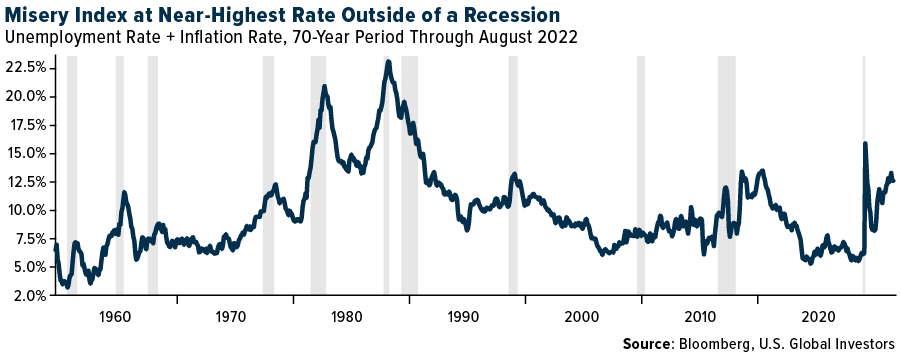
Cash Is King, but Bonds Also Look Attractive
With a recession potentially making landfall, and stocks slipping a further 5%+ this week, investors may wonder what their next move should be. Perhaps making no move is the best path forward, for now. It’s often said that cash is king in recessions, and today may be no exception. The Bloomberg Dollar Spot Index has advanced more than 14% so far in 2022, compared to the S&P 500, which has declined 22%, wiping out the past two years.
Government bonds are also having one of their worst years in recent memory. The iShares 1-3 Year Treasury Bond ETF (SHY), the largest such ETF with over $26 billion in assets, is currently down 4.4% for the year. This puts SHY on pace for its worst year in its 20-year history.
And yet if you know anything about bonds, it’s that as prices drop, yields rise. For this reason, Treasury bonds are starting to look like a possible buy again. The yield on the 10-year bond has climbed to nearly 3.7%, its highest since 2011, while two-year paper is trading with a yield as high as 4.1%, a level last seen in 2007. In both cases, that’s well above the S&P 500 dividend yield.
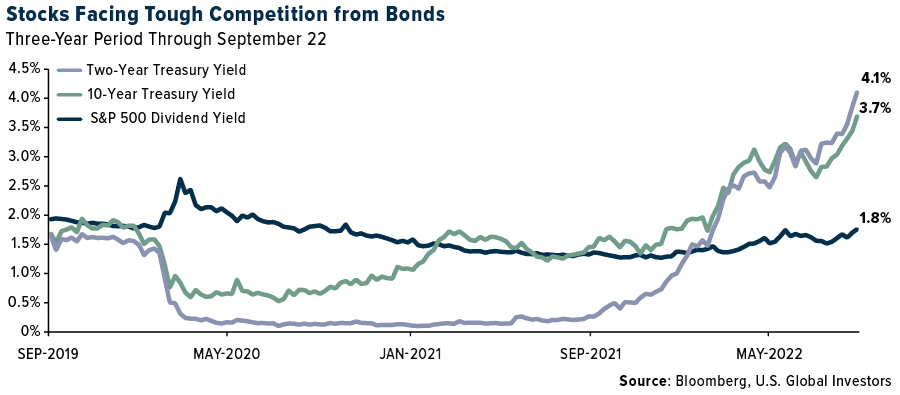
I should pause to point out that the spread between the short-term yield and long-term yield is now at its most pronounced since 2000, around the time of the tech bubble. This inversion indicates that investors are becoming more pessimistic of the U.S. economy over the next two years. What’s more, since 1955, every yield curve inversion has been followed by a recession in the subsequent months.
A Case for Optimism
Having said all that, I still urge readers to remain optimistic, even though nearly every sign points to further economic and financial pain.
There are many misconceptions about optimism, by the way. Some people maintain it’s the belief that only good things will happen. Others believe you have to be naïve to express optimism, or that only extraordinarily happy people can be optimistic.
I don’t think any of those things. I believe optimism is simply the acknowledgement that, while there may be setbacks along the way, some of them major, the odds of things working out in the end increase over time.
A perfect analogy is the stock market. Huge selloffs like the one we’re witnessing at the moment warp some people’s attitudes about investing. They see that the S&P is in correction territory and may conclude that investing is too risky. The reality is that stocks have been up three out of every four years, historically speaking.
I’ve been in the game for decades, and one of the most important lessons I’ve learned is that an optimistic attitude helps you identify opportunities where a pessimist may see only risks. There are always going to be risks, as we all know. Sometimes it’s best to avoid the risk altogether. Other times, taking on the risk dramatically increases your odds of achieving rewards beyond your wildest dreams.
Have a blessed weekend!

Index Summary
- The major market indices finished down this week. The Dow Jones Industrial Average lost 4.00%. The S&P 500 Stock Index fell 4.77%, while the Nasdaq Composite fell 5.07%. The Russell 2000 small capitalization index lost 6.68% this week.
- The Hang Seng Composite lost 4.89% this week; while Taiwan was down 3.04% and the KOSPI fell 3.89%.
- The 10-year Treasury bond yield rose 23 basis points to 3.687%.
Airlines & Shipping
Strengths
- The best performing airline stock for the week was Bangkok Airways, up 13.3%. Boeing CFO Brian West re-affirmed the company’s forecast to be free cash flow positive this year. The second half of 2022 should see a benefit in cash due to increased deliveries of the MAX and 787 aircraft. However, the Boeing Defense, Space & Security segment will also be a material tailwind to the full-year free cash flow. The company has $5 billion of debt maturing at the end of fiscal year 2023, with another $5 billion maturing in fiscal year 2024 that it expects to pay down with future cash generation from operations.
- Dry bulk freight rates have started to improve on seasonal tailwinds from grain and coal, combined with higher China-related typhoon congestion. Seasonality should remain supportive for the next one to two months, but China macro remains the central debate for 2023. Tanker rates moving higher may be supported in the months ahead on stronger-than-normal winter restocking and growing ton mile demand as European imports from Russia are curtailed.
- Turkish Airlines surprised the market positively during the second quarter, with fast de-leveraging that is largely supported by record-high quarterly EBITDA generation. Net debt declined to $9.4 billion, (2.5x EBITDA) from $11.3 billion in the first quarter (3.3x EBITDA); well below the company’s fiscal year guidance of $13-$14 billion. Financial performance was boosted by strong capacity build up that is 12% ahead of 2019’s second quarter and robust traffic (reaching pre-pandemic levels) helped the company to pass through rising fuel costs on fares much earlier than expected.
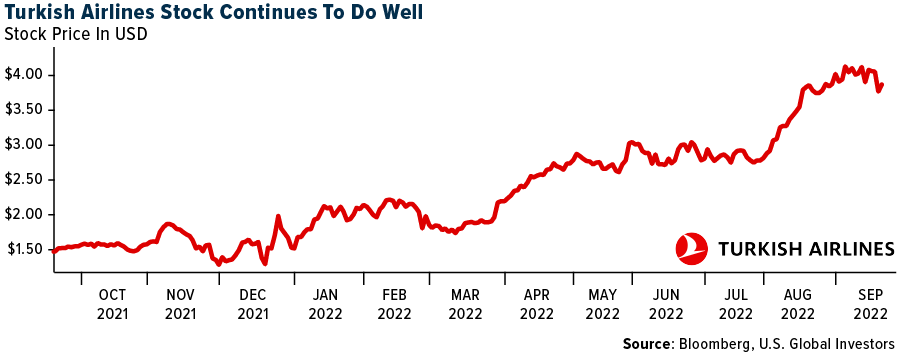
Weaknesses
- The worst performing airline stock for the week was Bombardier, down 17.9%. In China, from September 1-11, domestic demand was -55.2% year-over-year, and domestic PLF decreased to 68% (versus 71% in August).
- Alliance partners Maersk and MSC are calling off multiple voyages from China to Europe, indicating that the carriers forecast lower demand for container freight in the coming time, writes Alphaliner in its latest update. “The voyages are blanked to match capacity with the expected weaker demand,” according to the analyst firm. It furthermore tallies with recent weeks’ rates development, which last week took another dive across several key routes.
- Fourth quarter scheduled capacity has moved significantly for United Airlines. United’s reductions were largely internationally focused, with Shanghai, Beijing, Hong Kong, Tokyo, and Guam schedules being the most impacted. The company’s fourth quarter 2022 scheduled international ASMs fell to 26,613 MM from the 31,640 MM figure recently. San Francisco and Newark also saw noticeable schedule reductions for the carrier.
Opportunities
- According to JPMorgan, total industry summer capacity ran 9% below 2019, despite an economy that’s roughly 15% larger. Secondly, many U.S. consumers preferred to ride out the Omicron wave before gaining the confidence to book summer vacations. Lastly, continued international closures and the pre-departure Covid testing mandate (lifted mid-June, but by which time plans were baked for many), drove domestic substitution for those that might have customarily vacationed overseas, further exacerbating the competition for domestic availability.
- FedEx management detailed eight cost initiatives the company is implementing to adjust its structural cost base and reduce variable costs. Some of these initiatives include reducing flight frequencies and parking aircraft, reducing labor hours, consolidating some sort operations, and reducing Sunday operations in FedEx Ground.
- According to Air Canada, judging by booking curves, demand remains robust — particularly on the leisure side which is now above pre-pandemic levels. Further, management noted some encouraging behavioral trends, including: 1) pricing does not seem to be a factor (allowing the company to successfully pass on cost inflation); 2) customers are flying more frequently; and 3) there has been a high propensity of customers to elect for business class on leisure trips.
Threats
- Demand recovery and pilot staffing issues at regional airlines have driven the relative capacity levels in 2022 to exceed departures even above the 2019 trend. The “windfall” regional pilot pay increases of late (along with an elevated fuel price) should limit the recovery in regional lift.
- A lifting of Iran sanctions should drive-up demand for tankers while at the same time causing shrinkage of the tanker fleet. That is not to suggest there is no risk. Almost certainly peace in Ukraine would cause tanker equities to fall and there is risk of a nasty economic recession next year which, if bad enough, could cause oil demand to decline enough to negatively impact tankers (although lower prices are a self-correcting mechanism).
- The risk of an oil supply shock is heightened in the coming months, with upcoming elections across the EU/ the U.S. placing the September-October timeframe as a possible escalation point for energy prices.
Emerging Markets
Strengths
- The best relative performing country in emerging Europe for the week was Poland, losing 2.5%. The best performing country in Asia this week was Indonesia, gaining 0.1%.
- The Russian ruble was the best performing currency in emerging Europe this week, gaining 5.6%. The Pakistani rupee was the best relative performing currency in Asia this week, losing 0.2%.
- This week Poland released stronger economic data. Industrial/construction output climbed, retail sales were reported higher on a month-over-month and year-over-year basis, unemployment declined, and consumer confidence came in less negative than expected.
Weaknesses
- The worst performing country in emerging Europe for the week was Russia, losing 14.0%. The worst performing country in Asia this week was Hong Kong, losing 4.8%.
- The Polish zloty was the worst performing currency in emerging Europe this week, losing 3.6%. The Philippine peso was the worst performing currency in Asia this week, losing 2.3%.
- Bloomberg data shows that IPOs in Hong Kong represented just 7% of Asia’s total year-to-date. The data shows $7.75 billion has been raised through new listings this year, the lowest market share since 1999. Proceeds this year are down 78% year-over-year with rising interest rates, inflation, and Beijing’s zero-Covid policy being blamed for the steep fall.
Opportunities
- Russians who disapprove of Putin’s call for partial mobilization walked out this week protesting the dictator’s push to escalate fighting in Ukraine. This proves that a growing percentage of the Russian population is withdrawing support for President Putin and his aggressive strategy toward the country’s neighbors.
- China approved Hong Kong’s plans for reopening to global travelers. Shortly after, the Hong Kong government announced the end to its formal quarantine for international travelers after more than two-and-a-half years of stringent pandemic controls. Under new rules that will take effect starting September 26, incoming travelers will be required to undergo three days of self-monitoring on arrival. Although travel restrictions will not be fully removed, travel will become more convenient.
- Service and manufacturing PMIs for China will be released next week. Bloomberg economists predict the service index to remain above the 50 mark separating growth from contraction, at 52.6. However, the China/Caixin manufacturing PMIs will likely remain unchanged, below the 50 mark. The Caixin Manufacturing PMI, which measures the manufacturing activity among smaller private companies, is expected to be released at 49.4, slightly above the official China Manufacturing PMI at 49.5, which measures production activity among larger, state-owned entities.
Threats
- Russia escalated conflict in eastern Europe. President Putin called for partial mobilization, calling an additional 300,000 military personnel into service. In addition, referendum in the east and south regions of Ukraine will take place this weekend, asking people who leave whether they agree to join Russia. Following the event from Russia’s annexation of Crimea, the outcome of such a referendum seems obvious. At the same time, the President of Ukraine, Zelensky, wants to re-take all territory from Russia, including Crimea.
- Goldman Sachs cut China’s GDP growth forecasts for 2023 to 4.5% from a previous projection of 5.3%. It kept its 2022 GDP forecast of 3.0% unchanged. The bank said the cuts came after assessing that the country would not reopen fully until after the Lunar New Year holiday and next March’s parliament session.
- Last week, the MSCI Emerging Markets ETF (EEM) saw the biggest withdraws among ETFs that invest across developing nations (as well as those that target specific countries), Bloomberg reports. This exodus of money may continue as the dollar gets stronger. This week the Federal Reserve hiked its rate by 75 basis points, pushing the dollar to new highs.
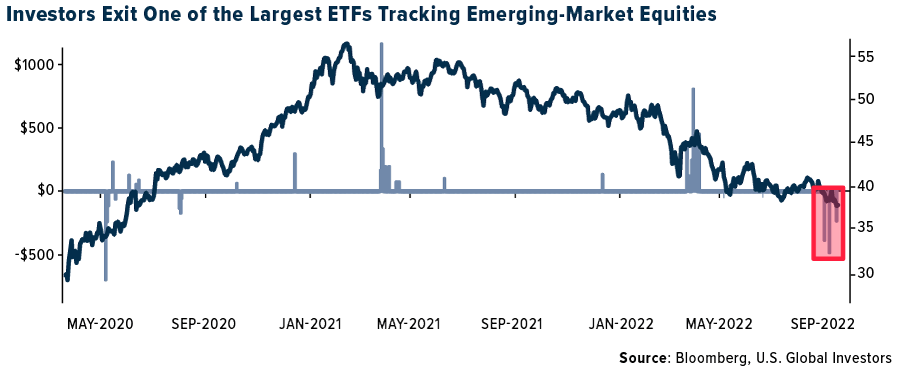

Energy and Natural Resources
Strengths
- The best performing commodity for the week was coffee, up 2.49%, on news at the start of the week that Brazilian coffee stocks have fallen to their lowest level since 1999. A board member of Brazil’s National Coffee Council noted that even if Brazil gets a good harvest next year, it will barely be enough to meet demand.
- In the refining sector, even assuming no China export control in the future, there may be a tight global refining supply-demand balance (especially for middle distillates) through 2024, driven by: 1) continued permanent capacity closures (overall 5.5 million bpd capacity closing between 2019 to 2023) and 2) elevated gas prices in Europe (providing cost curve benefits for Asian refineries and creating upside risk to diesel demand for heating into the winter season as an alternative to gas).
- European gas storage utilization has continued to increase at above-average rates in recent weeks despite the drop in Russian gas exports via Nord Stream 1. As of September 17, storage was 86% full versus the 10-year average of 84% and 71% at the same time last year. At average injection rates, there could be 90% inventory levels by the end of October. European Union gas consumption was down 18% year-over-year in August, after a 14% drop year-over-year in July, bringing the decline year-to-date to -12%.
Weaknesses
- The worst performing commodity for the week was natural gas, down 11.81%, and continuing its longest streak of weekly losses in January 2019. Fundamentals are becoming more bearish. U.S. gas inventories are up, and larger-than-expected stockpiles are signaling to the market that record production is now having an impact on prices, as demand wanes in the off season plus a slower economy.
- Gasoline inventories are running low on the West Coast and in the Midwest, as reported by Bloomberg. Consumers are again seeing surging prices at the gas pump, yet gasoline futures are falling in price. Refinery fires and unplanned shutdowns, on top of scheduled maintenance, sent wholesale prices in Los Angeles, San Francisco, and Portland to record highs. Stockpiles of gasoline in the U.S. are running at their lowest level in 14 years.
- The potash market sentiment continues to be bearish, as demand remains scarce and supply abundant, with incremental product from Belaruskali emerging across various regions. On the other side, Russia states it still faces a level of logistical export hurdles in terms of elevated insurance premia, securing trade finance/LoC, and product into Brazil has diminished over the last two months.
Opportunities
- Morgan Stanley is selectively turning more positive on mining equities as most stocks in its coverage trade at increasingly attractive stock valuations — global Metals & Mining stocks’ relative valuation stands at 1.4 standard deviations below their historical average — despite strong free cash flow generation, capex discipline, and low leverage.
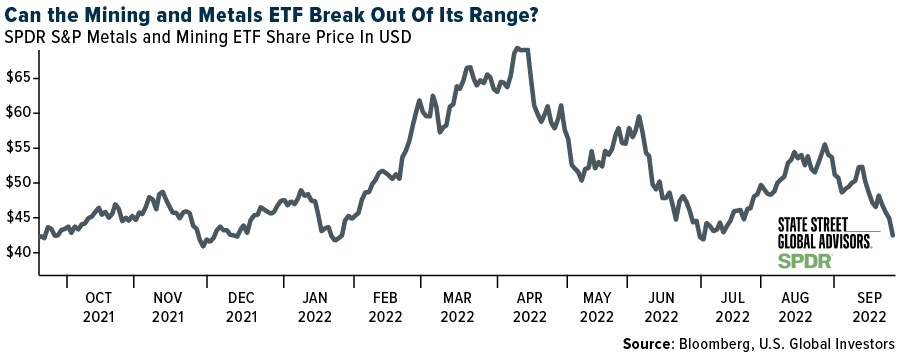
- After flattening in 2017-2018, footage drilled/rig/day in the Permian has steadily risen over 2019-2021 and year-to-date. It’s not surprising that 2019-2020 saw strong increases in rig efficiencies as declining activity typically results in high grading of the operator base and active rig fleet. What is surprising is that rig efficiency has continued to improve at a decent clip in 2021 and year-to-date despite rig activity doubling over this period, which runs counter to 2017-2018, when efficiencies flattened out as activity increased. Typically, less efficient rigs are added as activity increases.
- U.S. permitting activity increased in August with 1,306 approved permits compared to 1,152 permits in July. On a month-over-month basis (August versus July), the total approved permit count for horizontal wells increased by 154 permits, or 13.4%, to 1,306 permits. Private operators received 576 approved permits compared to 730 approved permits for public operators in August, which compares to private operators with 558 permits and public operators with 587 permits in July.
Threats
- According to Morgan Stanley, although mining equities have typically outperformed during periods of high inflation, risks around China demand for metals from a deepening housing downturn and a doubling-down on zero-Covid policy, along with a lingering energy crisis in Europe, are likely to remain obstacles to a broad sector re-rating. In fact, China property demand indicators, such as land sales and floor space starts, are still in deep contraction, offsetting an anticipated pick-up in infrastructure demand.
- LNG cost inflation appears under-reported by market players. There could be potentially 20-30% cost inflation for projects, or over $800 per ton construction costs. With many LNG prices still in the $2.00-$2.25/MMBtu range despite these emerging pressures, returns for projects could be eroded.
- As introduced in the U.K., a new windfall profit tax is expected to raise more than $30.9 billion (£28 billion) from oil and gas companies. The 25% tax on the profits of oil and gas will be used to offset government assistance to consumers on current purchases. Companies can invest in new production as an offset to the tax. Only the oil and gas industry is targeted by the newly proposed tax. U.S. investors should take notice of the transfer of revenue back to consumers via a tax as a potential threat to the earnings of our domestic oil and gas industry.
Luxury Goods
Strengths
- According to Bloomberg, the University of Michigan Consumer Sentiment Index, which shows consumer behavior related to discretionary expenditures, has increased. For September, it was reported at 59.5 versus the previous month’s reading of 58.2.
- According to Bloomberg and a report from Jones Lang LaSalle Inc., despite historical inflation levels globally, luxury spending in the U.S. is doing well, encouraging new store openings in the country. American spending on luxury items represented 31% of growth in total luxury market activity in 2021, versus 22% in 2019. Many brands are focusing on consumers in Florida and Texas as more and more people move to these Southern locations. For example, Gucci is building its first standalone retail location in San Antonio, TX, at La Cantera mall.
- Chow Tai Fook Jewellery Group, an Asian jewelry company, was the best performing S&P Global Luxury stock for the week, gaining 5.39%. Its trading volume rose 5.7% to 2.5 million shares, triple its 20-day average of 967,661 shares.
Weaknesses
- According to an article from GoBankingRates, the luxury goods market in 2021 reached $288 billion. Many consumers purchased such items for pleasure while others as an investment. Regardless, some luxury brands’ products don’t always hold their full value. For example, a Hermès handbag retains around 90% of its value. A Mercedes EQS Sedan (an electric vehicle) keeps 39% of its value over five years, the 2023 BMW 7 Series keeps around 36.6%, and Valentino handbags around 40%.
- Covid has had a significant impact on the global economy and one of the largest luxury goods markets in the world – China. Even the massive Chinese consumer market hasn’t been enough to save significant international investments in the luxury industry from local firms. According to Bloomberg, Shandong Ruyi Group invested hundreds of billions of dollars years ago, intending to become the “Chinese LVHM.” The company was encouraged by local authorities to build a consumption-driven economy like that of the U.S. Most of the global acquisitions weren’t successful, however. This large conglomerate is now looking to reverse all agreements, which represents a big failure for local Chinese companies to build their local luxury empire.
- The RealReal Inc, an American marketplace for luxury goods based in San Francisco, CA, was the worst performing S&P Global Luxury stock for the week, losing 25.93%. The company hit a record low of $1.78 this week and the stock declined 84.6% year-to-date.
Opportunities
- According to a Seeking Alpha article, in the context of high inflation levels and hiked interest rates by central banks worldwide, it’s difficult to expect great financial reports from companies spanning different industries. LVMH, one of the most valuable luxury brands worldwide, however, could be considered one of the exceptions. Consumers could continue buying its products, the author explains, because they believe their purchases are a good investment. The company reported excellent results from the first half of 2022. LVMH grew 28% in Europe from €28.66 billion in 2021 to €36.72 billion in 2022. The strengthening of the dollar is in its favor too.
- According to Credit Suisse Group AG’s Global Wealth Report 2022, the number of millionaires worldwide will reach over 87.7 million by 2026 (meaning those who will have at least $1 million in wealth). This represents an increase of 40%, globally. China will be the country adding the most millionaires, Bloomberg reports. This is favorable for the global luxury goods market, as more wealthy consumers will be spending more money.
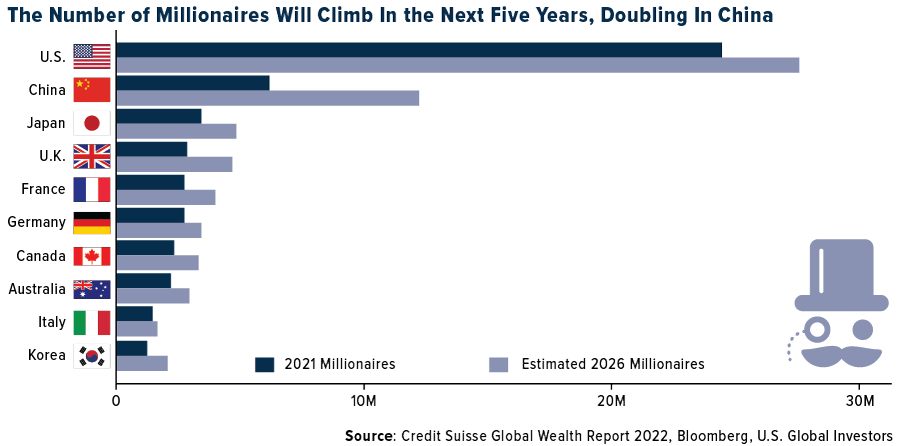
- As reported by Bloomberg, Abu Dhabi National Hotels (ADNH) is planning to build a luxury resort in Ras AI Khaimah for $272 million. The resort will have 1,000 rooms in an area of 1 million square feet. This significant investment will complement its portfolio across Abu Dhabi and Dubai. The company aims to become a leading luxury destination for tourists.
Threats
- Russia is one of the leading diamond suppliers worldwide. The secretive sale of Russian diamonds, worth hundreds of millions of dollars every month, is fracturing the global trade that stretches from cutting factories in Mumbai to luxury stores on New York’s Fifth Avenue, reports Bloomberg. Many in the industry refuse to deal in Russian gems following the invasion of Ukraine and after mining giant Alrosa PJSC was hit with U.S. sanctions, the article explains. But there’s a handful of Indian and Belgian buyers who are snapping up large volumes at lucrative terms, getting to pick and choose the diamonds they need while others stay away.
- This week, the U.S. Federal Reserve raised interest rates by 75 basis points in response to high inflation levels that were higher than expected in August. This means that the cost of carrying credit cards potentially increases, directly affecting consumers’ purchasing power. Short-term, it could represent a decrease in luxury goods sales.
- According to a Redfin report, in the last three months ending August, luxury U.S. home sales dropped 28.1% compared to the previous year. This is the most significant drop since 2012, even more prominent than the decline during the pandemic of 23.2%. This represents a substantial change in consumer behavior in response to high inflation, the fear of an imminent recession, and rising interest rates.
Blockchain and Digital Currencies
Strengths
- Of the cryptocurrencies tracked by CoinMarketCap, the best performer for the week was XRP, rising 49.29%.
- Nasdaq is making its first major push into crypto, reports Bloomberg, as the second-largest stock exchange prepares to capitalize on increasing appetite for digital currencies among big-money investors. A new group dedicated to digital assets will initially offer custody services for Bitcoin and Ether to institutional investors. As a custodian of digital assets, Nasdaq would be competing with crypto firms such as Coinbase, Anchorage Digital and Bitgo, the article continues.
- A crypto industry lobby wants the judge in a high-profile digital assets case to consider Congressional efforts to establish a new legal framework for the nascent industry before moving ahead, reports Bloomberg. The chamber of Digital Commerce, a crypto advocacy organization, filed an amicus brief Wednesday in the SEC lawsuit against Ripple Labs.
Weaknesses
- Of the cryptocurrencies tracked by CoinMarketCap, the worst performing for the week was RavenCoin, down 23.82%.
- A slide in cryptocurrencies on Monday sent Bitcoin to a three-month low as sentiment took a knock from a wave of monetary tightening that’s set to stretch from Europe to the U.S. Bitcoin sank as much as 7.4% and was trading at $18,644, which is the lowest since digital asset prices tumbled after the collapse of crypto lender Celsius in June, writes Bloomberg.
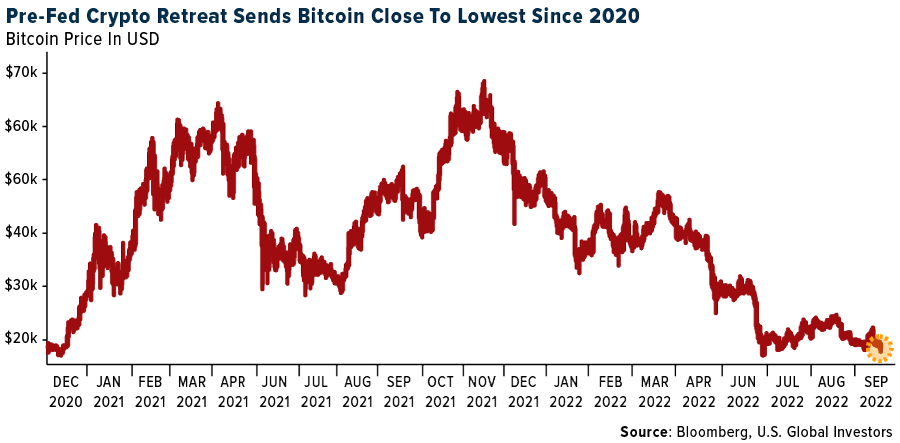
- Cryptocurrency hedge funds lost 4.9% in August, the most among all investment styles, according to Bloomberg Hedge Fund Indices. The Bloomberg All Hedge Index fell .2% in the month and lost 5.9% year-to-date. So far this year, cryptocurrency funds are down 41%, according to Bloomberg.
Opportunities
- Colorado taxpayers can now pay their taxes in Bitcoin, Ether, and other cryptocurrencies under a one-of-a-kind state tax payment program in conjunction with PayPal. Businesses and individuals will be able to use cryptocurrency assets to pay tax duties under Colorado’s primary tax programs, writes Bloomberg. Because Colorado can’t directly accept crypto itself, the Revenue Department has contracted PayPal to broker each transaction and immediately convert digital currencies into U.S. dollars.
- Cryptocurrencies outperformed U.S. equities for a change, with Bitcoin and Ether gaining for the first time in five days. Bitcoin rose about 2% on Friday and Ether rose about 1.5%. Markets are shuddering at the Fed’s determination to fight inflation by constricting financial conditions, writes Bloomberg.
- Cryptocurrency exchange FTX is in talks with investors to raise $1 billion in funding, CNBC reports. The valuation of billionaire Sam Bankman-Fried’s firm will be at $32 billion, according to the report. That’s the same as in January when the company raised $400 million, writes Bloomberg.
Threats
- The U.K.’s Financial Conducts Authority published a warning to consumers about Sam Bankman-Fried’s crypto exchange FTX, saying it isn’t authorized by the regulator to offer financial services or products in the country. The regulators said that FTX “is targeting people in the U.K.” adding that investors are “unlikely to get your money back if things go wrong,” writes Bloomberg.
- South Korean prosecutors signaled that Do Kwon, the progenitor for a $60 billion cryptocurrency wipeout, is at risk of an Interpol red notice and trying to evade redress over a meltdown that roiled digital assets. Kwon had moved from South Korea to Singapore, reports Bloomberg, where the now-collapsed Terraform Labs project had a base, but the city-state says he’s no longer there. Kwon’s location is unclear, and he denies being on the run even as prosecutors in Seoul seek his detention for allegations including breaches of capital-markets law.
- Jesse Powell, co-founder of crypto exchange Kraken, is planning to step down as CEO, Kraken confirmed with CoinDesk. Kraken’s current chief operating officer will take over as CEO until someone is hired to fill the position, according to an article published by CoinDesk.

Gold Market
This week gold futures closed at $1651.20, down $32.30 per ounce, or 1.92%. Gold stocks, as measured by the NYSE Arca Gold Miners Index, ended the week lower by 4.96%. The S&P/TSX Venture Index came in off 8.25%. The U.S. Trade-Weighted Dollar soared 2.95%.
| Date | Event | Survey | Actual– | Prior |
|---|---|---|---|---|
| Sep-20 | Housing Starts | 1450k | 1575k | 1404k |
| Sep-21 | FOMC Rate Decision (Upper Bound) | 3.25% | 3.25% | 2.50% |
| Sep-22 | Initial Jobless Claims | 217K | 213K | 208k |
| Sep-26 | Hong Kong Exports YoY | — | — | -8.9% |
| Sep-27 | Durable Goods Orders | -0.1% | — | -0.1% |
| Sep-27 | Conf. Board Consumer Confidence | 104.3 | — | 103.2 |
| Sep-27 | New Home Sales | 500k | — | 511k |
| Sep-29 | Germany CPI YoY | 9.5% | — | 7.9% |
| Sep-29 | Initial Jobless Claims | 220k | — | 213k |
| Sep-29 | GDP Annualized QoQ | -0.6% | — | -0.6% |
| Sep-29 | Caixin China PMI Mfg | — | — | 49.5 |
| Sep-30 | Eurozone CPI Core YoY | 4.7% | — | 4.3% |
Strengths
- The best performing precious metal for the week was gold, but still off 1.92%. Gold caught a break on Wednesday when the Bank of Japan intervened in the foreign exchange markets overnight to try and halt the slide in the yen against the dollar. Strength in the U.S. dollar is affecting world trade flows as the dollar is approaching trading levels not seen in the last 20 years. The rapid change has stressed balance sheets.
- Revival Gold reported new drill results for the Beartrack-Arnett Gold Project in Idaho. One of most significant intercepts was 3.49 grams per tonne (g/t) over 115.4 meters, which included 10.12 g/t gold over 11.4 meters. This hole was a 150-meter step out from a previous intercept of 4.34 g/t over 110.6 meters, which included 12.00 g/t gold over 13.7 meters. The continuity of the higher-grade subsection within the larger intercept raises the potential for better improved economics for the project.
- Iamgold Corporation is tracking toward the upper end of its 2022 production guidance of 570-640,000 ounces. The company noted it could have increased production guidance in the second quarter, but due to potential geopolitical risks in Burkina Faso, it remained conservative. Previously reported cost guidance is TCC of $1,100-$1,150 per ounce and AISC of $1,650-$1,690 per ounce.
Weaknesses
- The worst performing precious metal for the week was platinum, falling 4.95%, likely on anticipated weaker auto sales in the near future with an apparent recession playing out. Gold headed for a second weekly decline, reports Bloomberg, after a slew of central banks raised interest rates to cool inflation. Bullion slipped even lower on Friday, as the U.S. dollar climbed to a record.
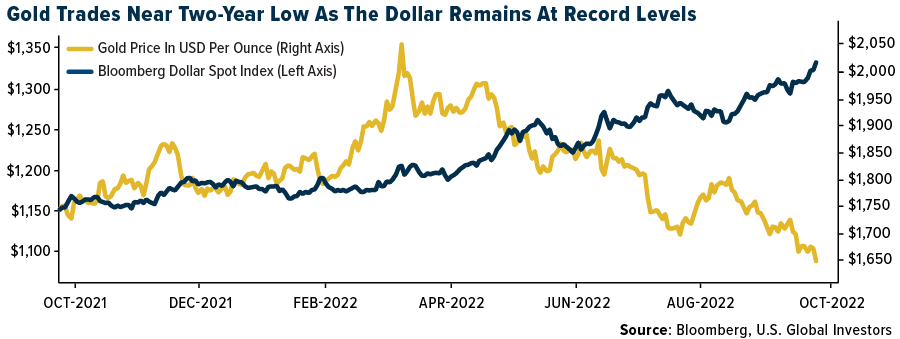
- CFO Daniella Dimitrov has left Iamgold Corp., and Vice President of Finance Maarten Theunissen has been appointed interim CFO. Management changes add uncertainty, in addition to Cote development issues and liquidity concerns.
- Newmont’s dividend remains a focus point, and it is reasonable to expect upcoming changes, including a net reduction. Management emphasized balance sheet flexibility was the company’s priority, and Newmont was in the process of evaluating key variables that affect its capital allocation. These include: 1) reserve pricing for gold, which could be increased from the current $1,200 per ounce by $100-$200 per ounce, and may impact the company’s current base dividend rate, and 2) industry inflation, which remains a factor into 2023, but is viewed as moderating into 2024. When evaluating the dividend, Newmont discussed 3.0% as being a notable threshold for some investors. It is unclear how the base dividend will change, a net reduction in the overall dividend as reasonable to expect at current gold prices.
Opportunities
- Newmont’s near-term capital profile includes high existing spending for the Tanami II and Ahafo North projects, which are guided to provide growth in 2026—the advancement of Yanacocha Sulfides would have exaggerated both near-term spending over 2022-25, and growth in 2026, ultimately increasing near-term cash flow risk. Project deferral reduces Newmont’s near-term capital risk profile, enabling the company to smooth its free cash flow (FCF) outlook and potentially sustain the existing dividend at current gold prices of $1,700 per ounce, while capital return sustainability risks could persist at lower gold pricing.
- According to UBS, platinum has diverse end uses; 85%-90% of palladium demand is for automotive catalysts. Since April, there has been a 36% recovery in ICE passenger vehicle sales in key end markets as the pent-up demand created by the order backlog was unwound after the easing of the chip shortage. During the year, UBS has constantly revised its primary platinum supply forecasts lower due to Russia’s invasion of Ukraine, disappointing operational updates and the recent two-month delay to the Amplats’ Polokwane smelter rebuild.
- Coeur Mining has announced that it has entered into a definitive agreement with AngloGold Ashanti to sell its Crown and Sterling holdings for closing cash consideration of $150 million and deferred cash consideration of $50 million to be paid upon Crown Sterling, attaining a total resource of at least 3.5 million gold ounces.
Threats
- UBS calculates that platinum margins are still close to record levels on a dollar per ounce basis and continues to forecast a gradual normalization in margins back to mid-cycle levels. However, in a falling platinum basket price, coupled with an elevated inflationary environment, there could be a quicker-than-expected normalization in sector margins. While a steepening cost curve could provide some support to prices, the basket price could trade closer to the 50th percentile in a severe cyclical downturn.
- AngloGold Ashanti acknowledged that mergers and acquisitions (M&A) activity is generally difficult to complete, and the best way for the company to add value is through organic growth opportunities. This is underpinned by the recent acquisition of Coeur Mining’s Nevada assets in the Beatty district.
- Gold sales in India may suffer this year as inflationary pressures and an erratic monsoon could hurt farmers’ incomes, reducing their ability to buy the precious metal. The livelihood of millions of farmers in the country depends on the annual monsoon, and uneven rains this year could hurt incomes in the farm sector, the biggest buyer of gold in India. An increase in the import tax in July also reduced appetite for the precious metal in the second-biggest consumer.

U.S. Global Investors, Inc. is an investment adviser registered with the Securities and Exchange Commission (“SEC”). This does not mean that we are sponsored, recommended, or approved by the SEC, or that our abilities or qualifications in any respect have been passed upon by the SEC or any officer of the SEC.
This commentary should not be considered a solicitation or offering of any investment product. Certain materials in this commentary may contain dated information. The information provided was current at the time of publication. Some links above may be directed to third-party websites. U.S. Global Investors does not endorse all information supplied by these websites and is not responsible for their content. All opinions expressed and data provided are subject to change without notice. Some of these opinions may not be appropriate to every investor.
Holdings may change daily. Holdings are reported as of the most recent quarter-end. The following securities mentioned in the article were held by one or more accounts managed by U.S. Global Investors as of (06/30/22):
Newmont Corp
IAMGOLD Corp
Boeing
AP Moller-Maersk
United Airlines
FedEx Corp
LVMH Moet Hennessy
*The above-mentioned indices are not total returns. These returns reflect simple appreciation only and do not reflect dividend reinvestment.
The Dow Jones Industrial Average is a price-weighted average of 30 blue chip stocks that are generally leaders in their industry. The S&P 500 Stock Index is a widely recognized capitalization-weighted index of 500 common stock prices in U.S. companies. The Nasdaq Composite Index is a capitalization-weighted index of all Nasdaq National Market and SmallCap stocks. The Russell 2000 Index® is a U.S. equity index measuring the performance of the 2,000 smallest companies in the Russell 3000®, a widely recognized small-cap index.
The Hang Seng Composite Index is a market capitalization-weighted index that comprises the top 200 companies listed on Stock Exchange of Hong Kong, based on average market cap for the 12 months. The Taiwan Stock Exchange Index is a capitalization-weighted index of all listed common shares traded on the Taiwan Stock Exchange. The Korea Stock Price Index is a capitalization-weighted index of all common shares and preferred shares on the Korean Stock Exchanges.
The Philadelphia Stock Exchange Gold and Silver Index (XAU) is a capitalization-weighted index that includes the leading companies involved in the mining of gold and silver. The U.S. Trade Weighted Dollar Index provides a general indication of the international value of the U.S. dollar. The S&P/TSX Canadian Gold Capped Sector Index is a modified capitalization-weighted index, whose equity weights are capped 25 percent and index constituents are derived from a subset stock pool of S&P/TSX Composite Index stocks. The NYSE Arca Gold Miners Index is a modified market capitalization weighted index comprised of publicly traded companies involved primarily in the mining for gold and silver. The S&P/TSX Venture Composite Index is a broad market indicator for the Canadian venture capital market. The index is market capitalization weighted and, at its inception, included 531 companies. A quarterly revision process is used to remove companies that comprise less than 0.05% of the weight of the index, and add companies whose weight, when included, will be greater than 0.05% of the index.
The S&P 500 Energy Index is a capitalization-weighted index that tracks the companies in the energy sector as a subset of the S&P 500. The S&P 500 Materials Index is a capitalization-weighted index that tracks the companies in the material sector as a subset of the S&P 500. The S&P 500 Financials Index is a capitalization-weighted index. The index was developed with a base level of 10 for the 1941-43 base period. The S&P 500 Industrials Index is a Materials Index is a capitalization-weighted index that tracks the companies in the industrial sector as a subset of the S&P 500. The S&P 500 Consumer Discretionary Index is a capitalization-weighted index that tracks the companies in the consumer discretionary sector as a subset of the S&P 500. The S&P 500 Information Technology Index is a capitalization-weighted index that tracks the companies in the information technology sector as a subset of the S&P 500. The S&P 500 Consumer Staples Index is a Materials Index is a capitalization-weighted index that tracks the companies in the consumer staples sector as a subset of the S&P 500. The S&P 500 Utilities Index is a capitalization-weighted index that tracks the companies in the utilities sector as a subset of the S&P 500. The S&P 500 Healthcare Index is a capitalization-weighted index that tracks the companies in the healthcare sector as a subset of the S&P 500. The S&P 500 Telecom Index is a Materials Index is a capitalization-weighted index that tracks the companies in the telecom sector as a subset of the S&P 500.
The Consumer Price Index (CPI) is one of the most widely recognized price measures for tracking the price of a market basket of goods and services purchased by individuals. The weights of components are based on consumer spending patterns. The Purchasing Manager’s Index is an indicator of the economic health of the manufacturing sector. The PMI index is based on five major indicators: new orders, inventory levels, production, supplier deliveries and the employment environment. Gross domestic product (GDP) is the monetary value of all the finished goods and services produced within a country’s borders in a specific time period, though GDP is usually calculated on an annual basis. It includes all private and public consumption, government outlays, investments and exports less imports that occur within a defined territory.
The S&P Global Luxury Index is comprised of 80 of the largest publicly traded companies engaged in the production or distribution of luxury goods or the provision of luxury services that meet specific investibility requirements.
The Bloomberg Dollar Spot Index (BBDXY) tracks the performance of a basket of 10 global currencies against the U.S. dollar.
Free cash flow (FCF) is the cash flow available for the company to repay creditors or pay dividends and interest to investors.
Target Audience: representative sample of US households (excluding Alaska and Hawaii)
Sample Size: please see CONSCASE Index
Surveys of Consumers collects data on consumer attitudes and expectations summarized in the Consumer Sentiment, in order to determine the changes in consumers’ willingness to buy and to predict their subsequent discretionary expenditures.
The Bloomberg Dollar Spot Index tracks the performance of a basket of ten leading global currencies versus the U.S. Dollar. Each currency in the basket and its weight is determined annually based on their share of international trade and FX liquidity.
The dividend yield is a financial ratio that tells you the percentage of a company’s share price that it pays out in dividends each year.









